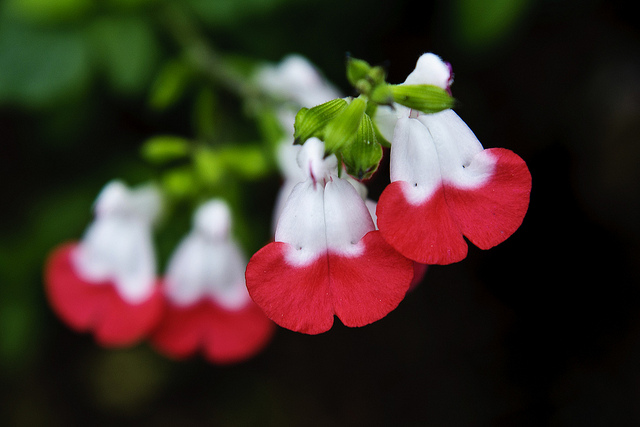
tel: 512-280-1192 Friday, June 29, 2012
Nursery Notes: A new shipment of gorgeous palms arrived this
week. 25% sale on these beauties this weekend. | Also in stock,
summer lovin' bougainvilleas, hibiscus, vinca, purslane moss rose,
and other native heat-lovers in their prime.
_____________________________________________________
Watermelon, Feta and Black Olive Salad: "As improbable as it
might sound," writes chef/writer Nigella Lawson, "this combination
is utterly fantastic, both savoury and refreshing at the same time."
Having tried it yesterday evening, I heartily agree! Something to
help gardeners make it through this roasting June/July heat.
_____________________________________________________
Central Texas Gardener (KLRU-TV): Author Cherie Colburn
tells some Bloomin’ Tales of Texas Wildflowers for the whole
family. On tour, meet a Texas transplant who learned a new garden
vocabulary. Saturdays noon or 4 p.m. or Sunday at 9 a.m.

Hot lips! It's easy to see where this amazing drought tolerant superstar got its name.
Hot Lips... and 4 other Rare Salvias
You Should Know About
By Amanda Moon
Plants from the salvia genus (known also as sages) have become
very popular in the last few years due to their extreme heat and
drought tolerance.
very popular in the last few years due to their extreme heat and
drought tolerance.
Although there are other plants commonly referred to as sage (i.e.
Russian and Jerusalem sage), the salvia genus contains the true
sages. The most well-known is probably Salvia greggii (aka autumn
sage). Culinary garden sage is also a salvia that’s just as hardy as
its ornamental counterparts.
Alongside these more common salvias, there are several you may
never have heard of that look beautiful in the landscape, and will
give you a little bit of different in your yard.
_______________________________________________________
1. Hot Lips (Salvia microphylla) is similar in growth habit to autumn
sage, but due to its slightly larger leaves it will tolerate anything from
full sun to light shade and still thrive. The flowers are an unusual com-
bination of red and white. Sometimes they are all red or white but will
also bloom in a mix of red and white on the same flower. Because of
its red flowers, this plant is popular with hummingbirds. Hot lips will
grow to a height and width of about 3’. It survived the last three years
without missing a beat — even in a neighborhood where no outside
watering was allowed last summer.
_______________________________________________________
2. Salvia namiensis is another trooper. (No common name for this; I
call it oak-leaf sage.) This low evergreen sub-shrub is a very unusual
sage. The leaves are lobed like an oak leaf, and it has a more prostrate
growing habit, reaching only 18”- 2’ tall, but can grow to a width of
5’. The pale purple flowers attract butterflies and bloom most of the
growing season. This is another salvia that survived the last three years
without any assistance at all, making it through last summer in full sun
on a corner of a yard without irrigation… and it still looks great.
_______________________________________________________
3. Forsythia Sage (Salvia madrensis) – named for its lemon yellow
flower spikes, is another top performer. It loves the shade and grows
quite tall, so it makes for a beautiful backdrop to other shade loving
plants ( like majestic sage). Another survivor from the last few years
of extreme Texas weather, this salvia typically blooms later in the
season and into the winter time, giving extra color when many plants
have finished their bloom cycles for the year.
_______________________________________________________
4. May Night (Salvia nemerosa) is a great early season bloomer. It is
a shorter sage with spikes of dark purple or pink flowers from early
spring until the heat of summer. Although it can get a little rangy in
the extreme heat, it bounces right back with little assistance.
_______________________________________________________
5. Salvia discolor (Andean sage) is a tender perennial with gray
leaves, white stems and almost black flowers. It has a semi-trailing
habit and looks beautiful in a container or flowerbed in morning
sun. In the full sun it gets too woody, so a bright porch or protected
location is best. The flowers appear consistently from late spring
until frost, or beyond if kept from freezing temperatures.
Happy Gardening Everyone!
 Visit the website: www.itsaboutthyme.com
Visit the website: www.itsaboutthyme.com